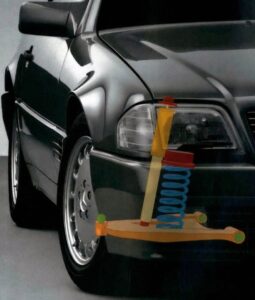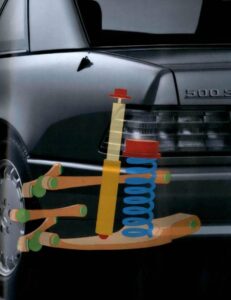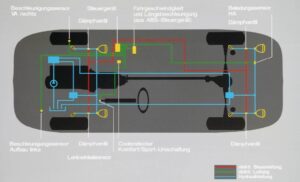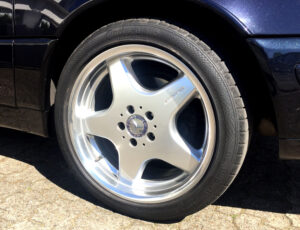Suspension innovation Mercedes R129
2. Front suspension: Smart simplicity
3. Rear suspension: Multi-link magic
4. Enter the adaptive era: ADS
7. Conclusion
A new chassis philosophy
While the R129’s looks were striking, the real transformation happened under the skin. Much of the new SL’s chassis technology was borrowed from the W124 E-Class, with foundational elements taken from the smaller W201 190-series. This platform synergy allowed the R129 to benefit from the latest in suspension design, with fine-tuned adaptations to suit its grand touring role.
Front suspension: Smart simplicity
Up front, the R129 featured a clean and efficient setup: a broad lower A-arm, with a separate coil spring and telescopic gas-filled damper. The damper was mounted close to the wheel carrier for better response, while the spring sat further inboard, helping to centralize mass and maintain balance. Unlike its R107 predecessor, which used five mounting points, the R129 simplified things with a three-point system that reduced complexity while enhancing NVH (noise, vibration, and harshness) isolation through rubber bushings.
A 30mm anti-roll bar ran across the front axle, and the steering joints were positioned behind it, enhancing stability and responsiveness. Mercedes engineered the geometry to retain a subtle amount of understeer—providing safe, predictable handling without sacrificing comfort. After all, harsh suspension setups might be fun in short bursts, but they’re rarely enjoyable over long distances or daily commutes.
Rear suspension: Multi-link magic
Perhaps the biggest advancement came at the rear, where the R129 adopted Mercedes’ all-new five-link independent suspension—originally developed for the 190E. The system was born from an internal design competition at Mercedes, eventually leading to what was called the “Stängle axle,” a sophisticated layout that cost over a billion Deutsche Marks to develop. It was worth every penny.
This multi-link rear suspension offered precise wheel control and superior handling characteristics, no matter how much weight was in the boot. Five individual arms—two lateral and three diagonal—ensured optimal load distribution and excellent ride isolation. Each was mounted with rubber bushings to absorb unwanted vibrations. An inboard coil spring and a gas-filled damper were positioned on each side, complemented by a lightweight 13mm anti-roll bar.
Mercedes engineers went a step further, refining the bushings and geometry to enhance the car’s dynamic behavior. The result? A 95% improvement in anti-squat and a 62% increase in anti-dive performance. As cornering forces increased, the rear suspension generated a subtle passive rear-wheel steering effect, increasing agility without adding complexity.
Enter the adaptive era: ADS
While the mechanical suspension was impressive on its own, Mercedes wasn’t content to stop there. Active suspension technology was the next frontier. Initially developed in partnership with Lotus—who were pioneers in Formula 1 active systems—Mercedes eventually chose to go it alone. By 1986, Daimler-Benz engineers had created their own system, better suited for integration with existing vehicle platforms.
The result was ADS: Adaptive Damping System. This revolutionary technology featured electronically controlled dampers that adjusted in real time—up to 100 times per second—based on inputs from five sensors. These measured variables such as speed, acceleration, braking, cornering force, steering angle, and suspension movement.
Drivers could toggle between “Comfort” and “Sport” modes, and the system constantly worked to optimize ride quality and handling. At high speeds (above 125 km/h or 78 mph), the car would automatically lower itself by 15mm to reduce lift and improve stability. On select models, the suspension could also be raised by 30mm at low speeds, improving ground clearance on rough or uneven roads—a practical nod to real-world usability.
Steering and braking
Power-assisted steering was, of course, standard. Mercedes opted for a variable-ratio recirculating ball setup, chosen for its ability to absorb harsh road shocks. With 3.2 turns lock-to-lock and a hydraulic damper, it delivered a refined and controlled feel—ideal for both autobahn cruising and spirited driving.
Braking was equally robust. Larger wheels allowed for larger brakes—ventilated 300mm discs up front with four-piston calipers and 278mm solid discs at the rear with two-piston calipers. This system offered excellent stopping power and came standard with ABS, underlining Mercedes’ commitment to safety.
Wheels and tires
Alloy wheels weren’t just a stylistic choice—they reduced unsprung weight, enhancing suspension performance. While the R107 ended its life with 15-inch alloys, the R129 arrived with 16-inch 8J wheels featuring an intricate 15-spoke design. Tires were typically Dunlop D40s or Pirelli P600s in a 225/55 ZR16 size, offering excellent grip and ride comfort.
Conclusion
Its blend of conventional mechanical excellence and cutting-edge electronic innovation made it a landmark car in the history of suspension development.
Whether gliding over imperfect roads or carving through mountain passes, the R129 delivered a uniquely refined driving experience. More than three decades later, it still stands as a testament to how engineering brilliance and luxury can be seamlessly integrated into one unforgettable package.
Are you already a proud owner of a Mercedes R129? If so, check out our selection of parts for this car at the following link:
Photos sources: r129.bplaced.de











